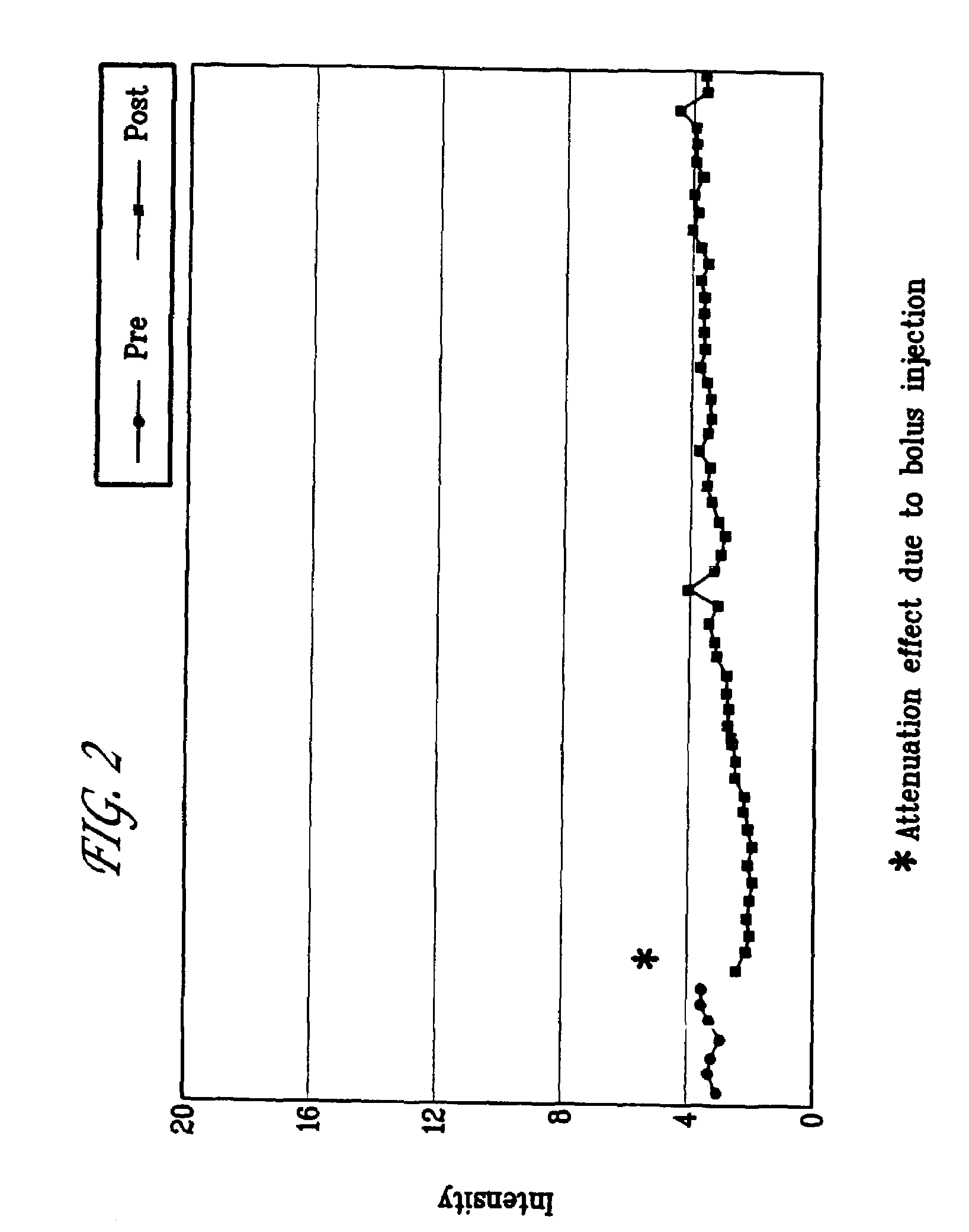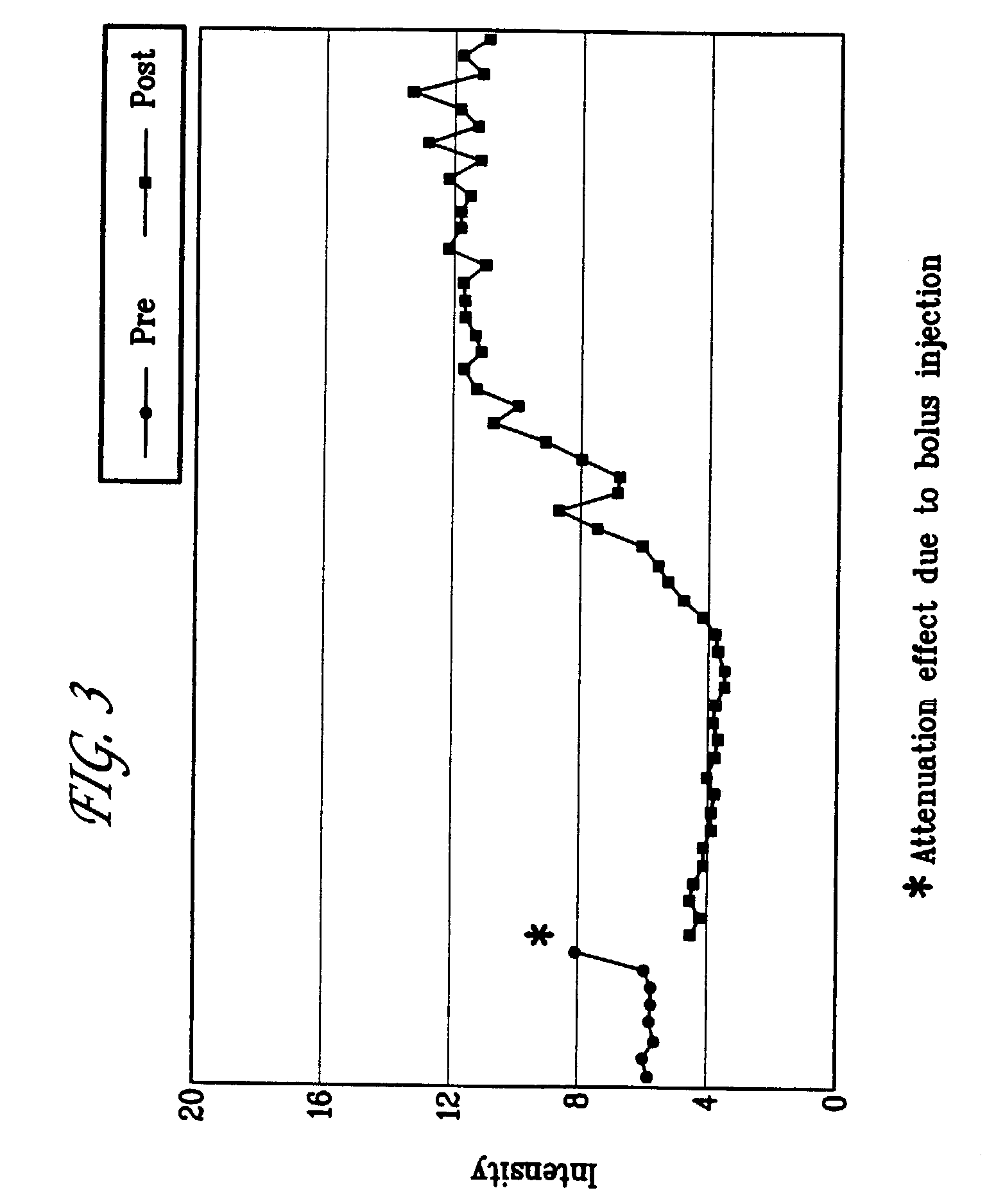Methods of imaging and treatment
a technology of imaging and treatment, applied in the field of targeted compositions, can solve the problems of difficult differentiation of tissue of interest from surrounding tissue in the resulting image, low relaxivity, and general toxicities of metal ions, and achieve the effect of increasing the signal received from microbubbles and decreasing background tissue signals
- Summary
- Abstract
- Description
- Claims
- Application Information
AI Technical Summary
Benefits of technology
Problems solved by technology
Method used
Image
Examples
example 1
[0462]This example is directed to the preparation of N,N′-bis(hexadecylaminocarbonylmethylene)-(β-N,N,N-trimethylammonium ethylaminocarbonylmethylene)-N,N′-dimethyl-N-N′-ethylenediamine tetraiodide (EDTA-HA-TMA tetraiodide), which has the following formula.
[0463]
A. Preparation of N,N′-bis-(hexadecylaminocarbonylmethylene)-ethylenediamine-N,N′-diacetic Acid (EDTA-HA)
[0464]
[0465]Ethylenediaminetetraacetic acid dianhydride (2.56 g, 0.01 mole) in dry methanol (30 mL) and hexadecylamine (4.82 g, 0.02 mole) in dry methanol (60 mL) were combined and stirred at 50° C. for 6 hours. The resulting white solid was isolated by filtration and dried at room temperature under vacuum to yield 3.43 g (64%) of EDTA-HA.
[0466]IR: 3320 cm−1 for OH, 1670 cm−1 for C═O (carbonyl).
B. Preparation of N,N′-bis-(hexadecylaminocarbonylmethylene)-N,N′-β-N,N-dimethylamino-ethylaminocarbonylmethylene)ethylenediamine (EDTA-HA-DMA)
[0467]
[0468]To a cooled (5° C.) solution of EDTA-HA from Step A (3.69 g, 0.005 mole), N,...
example 2
[0472]This example is directed to the preparation of N,N′-bis(hexadecyloxycarbonylmethylene)-N-(β-N,N,N-trimethylammoniumethyl-aminocarbonylmethylene)-N-methyl-N′-(carboxymethylene)ethylenediamine diiodide (EDTA-HAL-DMA diiodide), which has the following formula.
[0473]
A. Preparation of N,N′-bis-(hexadecyloxycarbonylmethylene)-ethylenediamine-N,N′-diacetic acid (EDTA-HAL)
[0474]
[0475]Hexadecyl alcohol (4.84 g, 0.02 mole), dry dimethylformamide (20 mL), dry triethylamine (3.3 g) and ethylenediaminetetraacetic acid dianhydride (2.56 g, 0.01 mole) were combined and stirred at 50° C. for 2 hrs. The reaction mixture was poured into cold water (200 mL) and the resulting aqueous mixture was acidified with HCl. The resulting white precipitate was isolated by filtration and the filter cake was washed with water. Recrystallization of the white solid from ethanol yielded 7 g of EDTA-HAL. m.p. 103° C.
B. Preparation of N,N′-bis(hexadecyloxycarbonylmethylene)-N-(β-N-dimethylaminoethylaminocarbonyl)...
example 3
[0479]This example is directed to the preparation of N,N′-bis(hexadecyloxycarbonylmethylene)-N-(β-N,N,N-trimethylammoniumethyl-aminocarbonylmethylene)-N-methyl-N′-(carboxymethylene)ethylenediamine diiodide (EDTA-HA-DMA diiodide), which has the following formula.
[0480]
A. Preparation of N,N′-bis(hexadecylaminocarbonylmethylene)-ethylenediamine-N,N′-diacetic Acid (EDTA-HA)
[0481]
[0482]Hexadecylamine (4.82 g, 0.02 mole) in dry methanol (60 mL) was added to a suspension of ethylenediaminetetraacetic acid dianhydride (2.56 g, 0.01 mole) in dry methanol (30 mL). The mixture was stirred at 50° C. for 6 hours. The resulting white solid precipitate was isolated by filtration and dried under vacuum at room temperature to yield 3.43 g (64%) of EDTA-HA. m.p. 156-158° C.
[0483]IR: 3320 cm−1 for OH; 1670 cm−1 for —C(═O)—.
B. Preparation of N,N′-bis(hexadecylaminocarbonylmethylene)-N,N′-bis(β-N,N-dimethylaminoethylaminocarbonylmethylene)ethylenediamine (EDTA-HA-DMA)
[0484]
[0485]To a cooled (5° C.) solu...
PUM
| Property | Measurement | Unit |
|---|---|---|
| Time | aaaaa | aaaaa |
| Time | aaaaa | aaaaa |
| Pressure | aaaaa | aaaaa |
Abstract
Description
Claims
Application Information
 Login to View More
Login to View More - R&D
- Intellectual Property
- Life Sciences
- Materials
- Tech Scout
- Unparalleled Data Quality
- Higher Quality Content
- 60% Fewer Hallucinations
Browse by: Latest US Patents, China's latest patents, Technical Efficacy Thesaurus, Application Domain, Technology Topic, Popular Technical Reports.
© 2025 PatSnap. All rights reserved.Legal|Privacy policy|Modern Slavery Act Transparency Statement|Sitemap|About US| Contact US: help@patsnap.com



